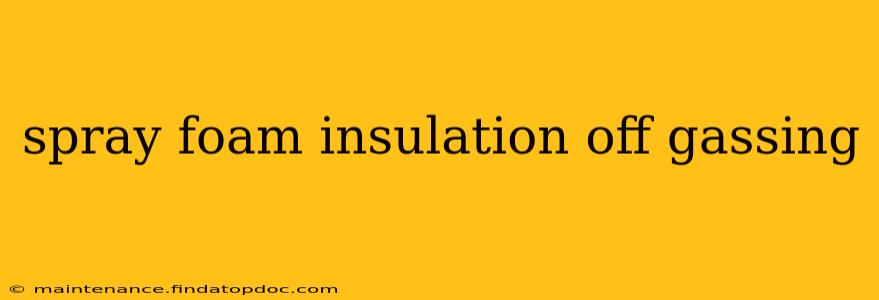Spray foam insulation, while offering excellent energy efficiency and air sealing, has raised concerns regarding off-gassing. This article delves into the complexities of spray foam off-gassing, explaining what it is, what causes it, and how to mitigate potential health risks. We'll address common questions surrounding this topic and provide practical advice for homeowners and professionals.
What is Spray Foam Insulation Off-Gassing?
Off-gassing refers to the release of volatile organic compounds (VOCs) from materials after they've been applied. In the case of spray foam insulation, these VOCs are released into the air as the foam cures and sets. The amount and type of VOCs emitted vary depending on the type of spray foam (open-cell vs. closed-cell), the specific chemical composition, and the curing process.
What VOCs are Released from Spray Foam Insulation?
The primary VOCs released by spray foam insulation include isocyanates, methylene diphenyl diisocyanate (MDI), and various other chemicals used in the formulation. The concentrations of these VOCs decrease over time as the foam cures, but some residual emissions can persist for months or even years, depending on factors like ventilation and environmental conditions.
Are there different types of spray foam insulation with varying levels of off-gassing?
Yes, absolutely. Open-cell spray foam generally releases more VOCs than closed-cell spray foam. This is because open-cell foam has a more porous structure, allowing for greater diffusion of gases. Closed-cell foam, with its denser structure, tends to off-gas less significantly, although it's not entirely VOC-free. Low-VOC or no-VOC spray foam options are also available, using modified formulations to minimize emissions.
What are the health effects of spray foam off-gassing?
Exposure to high concentrations of VOCs from spray foam can cause a range of short-term and long-term health problems. Short-term effects can include eye, nose, and throat irritation, headaches, and dizziness. Long-term exposure, at significantly elevated levels, has been linked to more serious health concerns, though the scientific community continues to study the long-term implications of lower-level exposure. Proper ventilation and following manufacturer guidelines are crucial to minimize risks.
How long does spray foam insulation off-gas?
The duration of off-gassing varies considerably. While the most significant emissions occur during the initial curing period (often the first few days to weeks), some VOCs can continue to be released for months or even years, albeit at decreasing concentrations. The rate of off-gassing is influenced by factors such as temperature, humidity, and ventilation.
How can I mitigate the off-gassing of spray foam insulation?
The best way to mitigate off-gassing is through proper ventilation. Ensure adequate air circulation during and after the installation process. This can involve using exhaust fans, opening windows, and utilizing air purifiers with HEPA filters capable of removing VOCs. Always follow the manufacturer's instructions for installation and ventilation recommendations. Choosing low-VOC or no-VOC spray foam is another crucial step to minimizing potential health risks.
Is spray foam insulation safe?
When properly installed and using appropriate ventilation strategies, spray foam insulation is generally considered safe. The risks are primarily associated with inadequate ventilation and exposure to high concentrations of VOCs during and immediately after installation. Choosing low-VOC or no-VOC options significantly reduces these risks.
What are the benefits of using spray foam insulation?
Spray foam insulation offers superior energy efficiency compared to traditional insulation materials, reducing energy bills and a home's carbon footprint. Its air-sealing properties significantly improve indoor air quality by reducing drafts and air infiltration. However, it's crucial to weigh these benefits against the potential off-gassing concerns and take steps to mitigate risks.
Disclaimer: This information is for general knowledge and should not be considered medical or professional advice. Always consult with qualified professionals for advice specific to your situation. Always refer to the manufacturer's safety data sheets (SDS) for detailed information on the specific VOCs present in the chosen spray foam insulation product.
